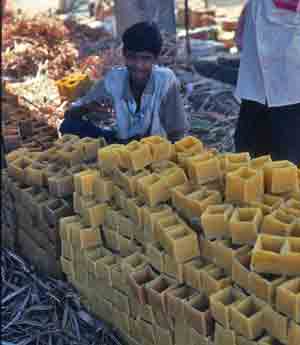
Sugar Cane Juice Stand, India
The previous six posts have featured chocolate, coffee, and tea. While these three came from different continents—North America, Africa, and Asia, respectively—they all became popular in Europe around the same time—the 1600s. With the use of chocolate, coffee, and tea growing and spreading rapidly, there was an even more rapidly increasing demand for one more item—sugar. Sugar had been around for a while by the time it was being sought to sweeten this caffeinated trio, but more was needed. And while there were other sources of sweetness around, when speaking of sugar, most people were and are thinking of sugar from sugarcane.
Sugarcane has an often vague and definitely checkered past. Because there is now no wild sugarcane growing anywhere in the world, it is hard to pinpoint its place of origin, but most scholars think it originated in India, on the shores of the Bay of Bengal. From there, once its sweet secrets were discovered, it spread rapidly to Malaysia, Indonesia, Indochina, and southern China.
It appears that the Dravidians, India’s denizens before the Aryans invaded from the north, pushing them southward, were the first to utilize sugarcane, though they were making molasses, rather than refined sugar. When the Aryans swept into India around 800 BC, they “rediscovered” sugarcane, and by 500 BC, appear to have created a machine that allowed them to create “crystal sugar.”
Sugar may have moved into Persia after Darius the Great visited India in the fifth century BC, but if it did, it remained too costly for commoners. It is possible that, instead of sugar, cane cuttings and technology were what the Persians carried away, but historians disagree on this. People in the ancient Middle East and Mediterranean did not have sugarcane at this time, but they knew about it, and the Bible refers to “sweet cane from a distant country.” Though they’d heard of it, Greeks and Romans didn’t use sugar.
It is not known when or where sugarcane was introduced to Europeans, but it is known that the introduction was made by Arab traders. The clues to a the likelihood of a relatively wide acquaintance with sugar are largely anecdotal, but they are compelling. Shakespeare and other writers in Elizabethan England were writing about sugar in the sixteenth century, using it in ways that suggest common knowledge. Marco Polo was familiar with sugar when he encountered it in China during the thirteenth century, and indeed, during the Middle Ages, Polo’s home town of Venice, the acknowledged queen of the spice trade, had made this new “spice” part of her lucrative trade monopoly.
Once sugar was commonly available, Italians became the first major addicts. Because sugar was expensive, it was another way the wealthy could show off, and soon every part of the meal was being sweetened, including the pasta dishes. France was a little more restrained, but still took to sugar wholeheartedly. Household accounts began to list “white sugar” in the 1300s, and Charles V was known to sprinkle sugar and cinnamon on his toasted cheese. The first book about cooking with sugar was published in Venice in 1541 and had been translated into French by the following year. The first book on sugar written in French was published (rather surprisingly) by Nostradamus in 1555.
The Age of Exploration brought about the next big jump in sugar’s history. Once Vasco da Gama reached India, Portugal was able to break Venice’s monopoly on the sugar trade. And gosh, hadn’t Europeans just discovered the best possible places to introduce the growing of sugarcane. Soon, fields of cane were waving beneath the bright sun of South America and the Caribbean (or West Indies, as the islands were then known). As noted above, because of the increasing popularity of coffee, tea, and chocolate, the demand for sugar was skyrocketing. Unfortunately, the solution hit upon for growing the increasing amount of sugarcane needed was the slave trade. The West Indies and sugar became an important part of the notorious Triangle Trade and were major players in the early economy of the New World.
Sugar is still big business. With slavery no longer part of its growing and processing, we can eat sugar without pangs of conscience, but there is an increasing concern over the health effects of eating too much sugar. Interestingly, while too much sugar is a health hazard, sugar itself is less damaging than some of the alternatives now being widely used in the U.S., most especially high fructose corn sweetener. In small quantities, sugar is a soothing and pleasant treat that is now one of life’s cheapest thrills.

Young Jaggery Seller, India
Copyright ©2010 Cynthia Clampitt





